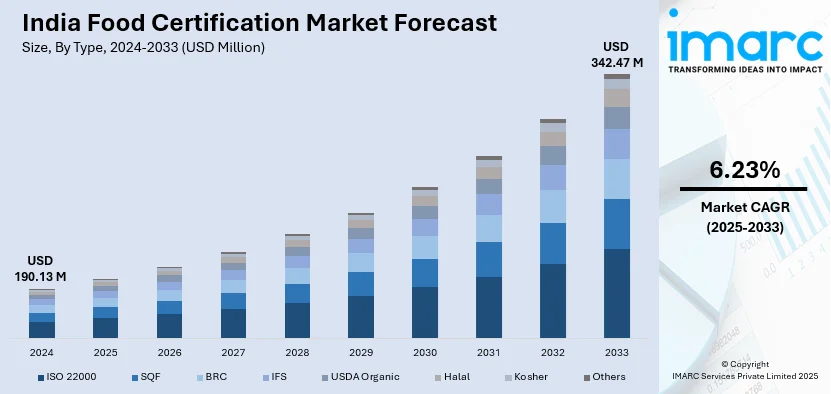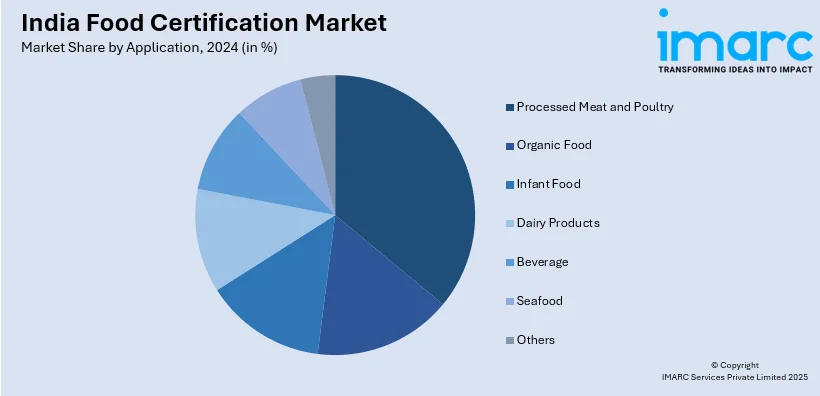
India Food Certification Market Size, Share, Trends and Forecast by Type, Application, and Region, 2025-2033
India Food Certification Market Size and Share:
The India food certification market size reached USD 190.13 Million in 2024. Looking forward, IMARC Group expects the market to reach USD 342.47 Million by 2033, exhibiting a growth rate (CAGR) of 6.23% during 2025-2033. The rising consumer awareness about food safety, increasing demand for quality standards, regulatory frameworks, growing export opportunities, and the expansion of organized retail and food processing sectors are some of the factors propelling the growth of the market.
|
Report Attribute
|
Key Statistics
|
|---|---|
|
Base Year
|
2024
|
|
Forecast Years
|
2025-2033
|
|
Historical Years
|
2019-2024
|
| Market Size in 2024 | USD 190.13 Million |
| Market Forecast in 2033 | USD 342.47 Million |
| Market Growth Rate 2025-2033 | 6.23% |
India Food Certification Market Trends:
Strengthened Food Safety Regulations
The government has substantially strengthened food safety rules to ensure the supply of safe and nutritious food. Standards for food manufacturing, storage, distribution, and sale are defined by a designated regulating authority. Compliance is constantly checked by routine inspections, audits, and sampling. Surveillance efforts are carried out nationally, with an emphasis on detecting suspected adulteration in essential food goods. Furthermore, regional governments employ local enforcement measures, allowing for more personalized approaches to food safety hazards based on regional consumption trends and emergent issues. This integrated strategy promotes both consumer safety and the overall objective of preserving food quality across the country. For example, in March 2025, the government of India enacted the Food Safety and Standards (FSS) Act 2006, establishing the FSSAI to set standards for food safety. The FSSAI regulates food manufacture, storage, distribution, and sale to ensure safe consumption. It monitors compliance through inspections, audits, and sampling. In FY2023-2024, FSSAI introduced the National Annual Surveillance Plan and conducted pan-India surveillance on staple foods, while states/UTs implemented local enforcement and surveillance measures.

Streamlined Food Safety Certification Process
Recent changes in India's food safety regulations have simplified the certification process for food products. Under the updated rules, food businesses are now required to obtain certification only from the food safety authority, removing the need for additional certifications from other bodies. This streamlining reduces regulatory complexity and promotes ease of doing business for food companies. By eliminating redundant certifications, businesses can focus on meeting safety standards more efficiently, reducing costs and time delays. This adjustment not only simplifies the certification process but also encourages faster market entry and broader industry growth. The move is expected to strengthen food safety measures while fostering a more business-friendly environment within the sector. For instance, in February 2024, the government of India approved amendments to food safety regulations, streamlining the certification process for food products. Following these amendments, only FSSAI certification would be required, eliminating the need for additional certifications from the Bureau of Indian Standards (BIS) or AGMARK. This move aims to enhance ease of doing business under the "One Nation, One Regulator" framework, reducing complexity for food businesses.
India Food Certification Market Segmentation:
IMARC Group provides an analysis of the key trends in each segment of the market, along with forecasts at the region/country level for 2025-2033. Our report has categorized the market based on type and application.
Type Insights:
- ISO 22000
- SQF
- BRC
- IFS
- USDA Organic
- Halal
- Kosher
- Others
The report has provided a detailed breakup and analysis of the market based on the type. This includes ISO 22000, SQF, BRC, IFS, USDA organic, halal, kosher, and others.
Application Insights:

- Processed Meat and Poultry
- Organic Food
- Infant Food
- Dairy Products
- Beverage
- Seafood
- Others
A detailed breakup and analysis of the market based on the application have also been provided in the report. This includes processed meat and poultry, organic food, infant food, dairy products, beverage, seafood, and others.
Regional Insights:
- North India
- South India
- East India
- West India
The report has also provided a comprehensive analysis of all the major regional markets, which include North India, South India, East India, and West India.
Competitive Landscape:
The market research report has also provided a comprehensive analysis of the competitive landscape. Competitive analysis such as market structure, key player positioning, top winning strategies, competitive dashboard, and company evaluation quadrant has been covered in the report. Also, detailed profiles of all major companies have been provided.
India Food Certification Market News:
- In March 2025, the Bureau of Indian Standards (BIS) established standards on respiratory protection, fall prevention, and fire safety to ensure the overall occupational health and safety of workers. These standards were implemented to enhance workplace safety, addressing critical hazards in various industries. The initiative aimed at improving worker protection through specific guidelines, ensuring compliance with safety measures, and reducing risks associated with respiratory issues, falls, and fire-related incidents.
- In February 2025, Tetra Pak became the first company in India's food and beverage packaging industry to introduce packaging with 5% certified recycled polymers. Starting April 1, 2025, the new packaging complies with the Plastic Waste Management (Amendment) Rules 2022. The materials are certified by ISCC PLUS, ensuring high environmental standards. This initiative supports the transition toward more sustainable packaging solutions and is part of Tetra Pak's broader efforts to reduce reliance on virgin plastics.
India Food Certification Market Report Coverage:
| Report Features | Details |
|---|---|
| Base Year of the Analysis | 2024 |
| Historical Period | 2019-2024 |
| Forecast Period | 2025-2033 |
| Units | Million USD |
| Scope of the Report |
Exploration of Historical Trends and Market Outlook, Industry Catalysts and Challenges, Segment-Wise Historical and Future Market Assessment:
|
| Types Covered | ISO 22000, SQF, BRC, IFS, USDA Organic, Halal, Kosher, Others |
| Applications Covered | Processed Meat and Poultry, Organic Food, Infant Food, Dairy Products, Beverage, Seafood, Others |
| Regions Covered | North India, South India, East India, West India |
| Customization Scope | 10% Free Customization |
| Post-Sale Analyst Support | 10-12 Weeks |
| Delivery Format | PDF and Excel through Email (We can also provide the editable version of the report in PPT/Word format on special request) |
Key Questions Answered in This Report:
- How has the India food certification market performed so far and how will it perform in the coming years?
- What is the breakup of the India food certification market on the basis of type?
- What is the breakup of the India food certification market on the basis of application?
- What are the various stages in the value chain of the India food certification market?
- What are the key driving factors and challenges in the India food certification market?
- What is the structure of the India food certification market and who are the key players?
- What is the degree of competition in the India food certification market?
Key Benefits for Stakeholders:
- IMARC’s industry report offers a comprehensive quantitative analysis of various market segments, historical and current market trends, market forecasts, and dynamics of the India food certification market from 2019-2033.
- The research report provides the latest information on the market drivers, challenges, and opportunities in the India food certification market.
- Porter's five forces analysis assist stakeholders in assessing the impact of new entrants, competitive rivalry, supplier power, buyer power, and the threat of substitution. It helps stakeholders to analyze the level of competition within the India food certification industry and its attractiveness.
- Competitive landscape allows stakeholders to understand their competitive environment and provides an insight into the current positions of key players in the market.
Need more help?
- Speak to our experienced analysts for insights on the current market scenarios.
- Include additional segments and countries to customize the report as per your requirement.
- Gain an unparalleled competitive advantage in your domain by understanding how to utilize the report and positively impacting your operations and revenue.
- For further assistance, please connect with our analysts.
 Inquire Before Buying
Inquire Before Buying
 Speak to an Analyst
Speak to an Analyst
 Request Brochure
Request Brochure
 Request Customization
Request Customization




.webp)




.webp)












